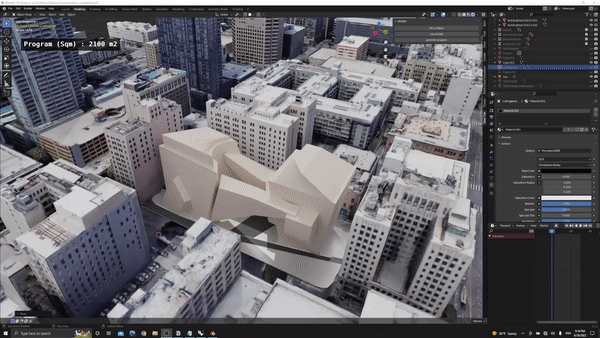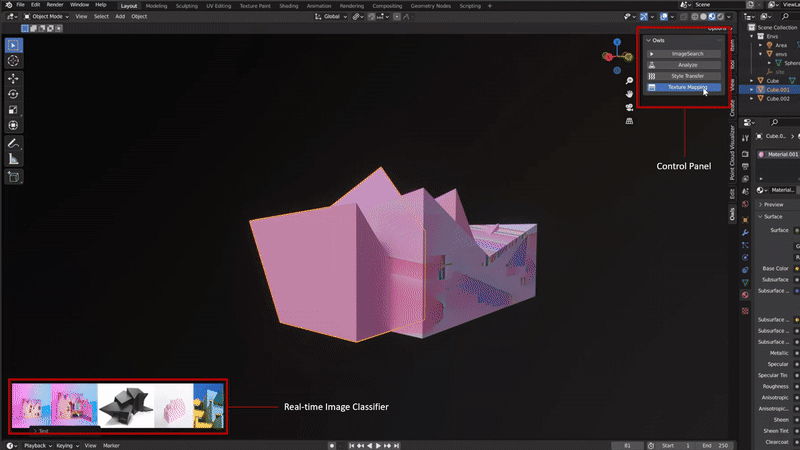

Advances in 3D modeling software continue to develop year after year. An example of this is a new thought-provoking 3D modeling plug-in designed by SCI-Arc EDGE graduate Jimmy Wei-Chun Cheng. His work offers a new way to challenge design "from the perspective of toolmaking and AI technologies [...] The plug-in proposes an alternative model to existing applications of AI and procedural methods."
In our latest Thesis Review installment, the SCI-Arc Architectural Technologies EDGE graduate shares his thesis project, Artificial Imagination Owl. During our interview, Cheng discussed the motivations behind his project and how it can help reshape "real-time ideation feedback" for users. Cheng explained that his project is a "Human x AI cooperation 3D modeling plug-in" that was designed to "awaken our awareness of the cliché in architectural design but also to contemplate how designers can engage with AI Machine Vision/Machine learning differently in the recent AI Architecture proliferation."
Tell us about your thesis/final project.
Owl is a Human x AI cooperation 3D modeling plug-in that can be implemented into the 3D modeling software Blender. It provides real-time ideation feedback to the user. It can assist designers in increasing decision-making efficiency and stimulate creativity at the same time. Pedagogically, this plug-in was designed not only to awaken our awareness of the cliché in architectural design but also to contemplate how designers can engage with AI Machine Vision/Machine Learning differently in the recent AI Architecture proliferation.
Owl accelerates the speed of concept design, assisting the designer in producing a stylized design based on the curated dataset. It can assist designers in creating inconsistent multiple options expediently. The plug-in proposes an alternative model to existing applications of AI and procedural methods, privileging collaborative high-speed interaction with AI in the design process over complicated or fixed workflows. It was awarded the SCI-Arc Hsinming Fung and Craig Hodgetts Thesis Award for Best Postgraduate Thesis, which awards a postgraduate project that challenges and contributes to the cutting-edge architectural discourse.
My thesis can be understood as a recommendation AI system that influences people’s decision-making in the design process. My project functions like “You may also like…” or “People also viewed these items…” in any digital web platform.

What motivated you to pursue this topic?
Before I enrolled in SCI-Arc, I worked in a few offices across different countries. Each office has its own workflow and method of designing architecture. Sometimes the same idea can be executed in a widely divergent direction because of the tool each office use. My curiosity about the tool and architecture was gradually evolved since then.
Having a passion for design. Some questions like, how is the idea formed? How to find inspiration? How to design architecture with a specific style but be innovative? All these questions are what I am interested in research. So, I asked these questions with the tool I developed in my thesis to search for the potential and possible answers to fulfill my curiosity.
How would you describe your thesis to someone who doesn’t have an architecture background?
My thesis can be understood as a recommendation AI system that influences people’s decision-making in the design process. My project functions like “You may also like…” or “People also viewed these items…” in any digital web platform. As Kate Crawford mentioned in her book Atlas of AI, “artificial intelligence is a registry of power.” I want to use platform capitalism as an example to show that the general aesthetic of architectural style is highly controlled by the algorithm behind different platforms. What kind of design style would attract more customers to a coffee shop? What decorations of the interior would have the most clicks on Instagram? What pops up more often when you search Architecture on Pinterest or Google? I would say my project is more closely related to a psychological experiment to arouse awareness of the impact of the AI technology behind contemporary design practice and potentially further expand to other industries as well.

I would say my project is more closely related to a psychological experiment to arouse awareness of the impact of the AI technology behind contemporary design practice and potentially further expand to other industries as well.
Does your thesis fit within the architecture discipline, or does it challenge it?
I believe the architectural discipline is inseparable from any form of technology. (Here, the discussion of technology is not limited to digital technology. Paper, pencil, or any analog technology is included.) A new theory, style, or movement might be initiated with a written text or an idea, but it eventually needs a new technical invention to achieve the realization. My thesis project focuses on challenging the idea of architectural design from the perspective of toolmaking and AI technologies. A new tool always leads to a new type of architectural style. But none of the tools was originally designed for architectural design, for instance, Rhino, Maya, or even Revit. Irrefutably, these tools indeed have reformed architectural design. With AI proliferation today, what would be the next 3d modeling tool that will subvert the cliché of architectural design is that I’m intrigued to challenge the architecture discipline.

How has your thesis influenced your architectural perspectives?
It connects the dots throughout my educational experiences. My first professional degree is M.Arch from RISD. I was obsessed with drawings and architectural representation. My interest was in descriptive geometry and representation theory from Alberti. And what I learned from SCI-Arc Architectural Technologies is to think of architectural form or geometries by bits and bytes. I started to realize the architecture we are building today is associated with all kinds of digital tools. As Mario Carpo describes in the book, The Second Digital Turn, “Architect did not invent digital design and fabrication however, digital technologies introduced a new culture and economics of data that changed our ways of making so to thinking.” Therefore, my fascination with the topic “tools and technologies” is a self-reflection of my architecture knowledge and belief in architecture. As I see it, this thesis helps me to find my position in the architecture discipline both professionally and academically.

As a recent graduate, how do you feel about the architecture industry right now?
I wish I could have more time to discuss this topic. To answer this question, I would like to discuss what kind of architectural offices we have today. Firstly, we have design studios, ateliers, or small offices that operate closer to the studio culture in academia. Their work covers small houses, international competitions, and research projects. Students like to work with these kinds of offices because these offices seem more interesting to work with. However, not too many people can work for this type of office for a long time when they find out this type of office often has low pay and high working hours. The passion eventually gets worn out.
And we also have what we call commercial or cooperate architectural offices, which provide better compensation and benefits but might work slightly differently from what we have been educated to do as a designer. I think there is an enormous gap between professional practice and academia. I cannot help but rethink the architecture institution's current pedagogical model. I think the position of the institution plays a critical role in lubricating the confrontation between each side involved.
What are your next steps? Academically/professionally?
I am working on building a few new design platforms/software that enable designers to work more efficiently and continue to research the potential of AI and Simulation in architectural design. This year, I aim to publish a few small tools and hold a few workshops to test the potential of new tools with students.
Has your architectural education prepared you for professional practice and employment?
Yes and No. Just like I said previously, working in the architectural office in another story from the school. I would say my architectural education equips me with a more comprehensive perspective in thinking about architectural problems and tackling practical tasks. However, it does not necessarily educate me in having the directly applicable skills or knowledge in the building industry. It is completely fine for me because I do not think architectural education needs to be like a trade school that only teaches you practical skills. I am satisfied with my architectural education.
What music do you listen to when working?
Soft Japanese playlist on YouTube
Mac or PC?
PC
What’s your go-to work outfit? Does it include black?
Minimalist. Yes, black and white.
Dream architect to work with (living or dead)?
Peter Eisenman
Best advice given to you by an instructor/tutor/etc.?
Pens down a few days before any presentation
What’s an overrated architecture term?
Design
Archinect's Spotlight on Thesis Projects: Archinect's commitment to highlighting student work doesn't stop at simply sharing projects. Our editorial team focuses on connecting with students and asking questions to learn their process, architectural perspectives, and their take on the industry as young designers. To support recent and promote recent graduates, we've launched our latest iteration of Archinect's Thesis Review to highlight the work of thesis students during this unique time of hybrid and remote learning. Be sure to follow our Thesis Review tag to stay up to date as we release new project highlights.
Katherine is an LA-based writer and editor. She was Archinect's former Editorial Manager and Advertising Manager from 2018 – January 2024. During her time at Archinect, she's conducted and written 100+ interviews and specialty features with architects, designers, academics, and industry ...
3 Comments
Excellent, Jimmy! With the exception of correlating this AI study with the exhaustive feeds and trendy disposable culture of social media, the more people like you spearheading the technology, the better.
Pop in the Bentley API for Rhino in Revit and unroll to the fullest delight. Great work!
That ending was savage. *slow clap*
"What’s an overrated architecture term?
Design"
Block this user
Are you sure you want to block this user and hide all related comments throughout the site?
Archinect
This is your first comment on Archinect. Your comment will be visible once approved.